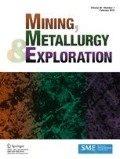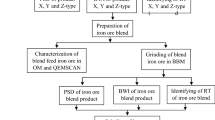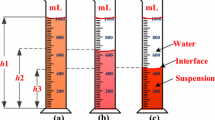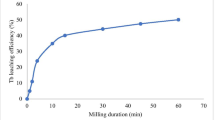Abstract
Iron ores obtained from different sources differ in their chemical and physical properties. These variations make the process of grinding a difficult task. The work carried out in this context focuses on three different samples of iron ore, viz., high silica high alumina, low silica high alumina, and low silica low alumina. The grinding process for all the three iron ores is carried out individually in Bond’s ball mill and the total retention time taken by each iron ore sample is calculated. The present investigation focuses on utilizing the calculated retention time of the iron ore as a standard grinding reference time to the laboratory ball mill for optimizing the grinding time of each ore. The desired P80 (150 μm) with an acceptable range of hematite liberation (> 75%) was obtained in the laboratory ball mill after reducing 6 min from the total retention time taken in the Bond ball mill.













Similar content being viewed by others
References
Saeidi N, Noaparast M, Azizi D, Aslani S, Ramadi A (2013) A developed approach based on grinding time to determine ore comminution properties. J Min Environ 4:105–112
Narayanan SS, Whiten WJ (1988) Determination of comminution characteristics from single-particle breakage tests and its application to ball-mill scale-up. Trans Inst Min Metall 97:115–124
Singh V, Dixit P, Venugopal R, Venkatesh KB (2018) Ore pretreatment methods for grinding: journey and prospects. Miner Process Extr Metall Rev 40:1–15
Shi FN, Napier-Munn TJ, Asomah IK (2007) Rheological effects in grinding and classification. Miner Process Extr Metall Rev 20:123–131
Rodríguez BÁ, García GG, Coello-Velázquez AL, Menéndez-Aguado JM (2016) Product size distribution function influence on interpolation calculations in the Bond ball mill grindability test. Int J Miner Process 157:16–20
Ahmadi R, Shahsavari S (2009) Procedure for determination of ball Bond work index in the commercial operations. Miner Eng 22:104–106
Aguado JMM, Velázquez ALC, Tijonov ON, Díaz MAR (2006) Implementation of energy sustainability concepts during the comminution process of the Punta Gorda nickel ore plant (Cuba). Powder Technol 170:153–157
Jankovic A, Suthers S, Wills T, Valery W (2015) Evaluation of dry grinding using HPGR in closed circuit with an air classifier. Miner Eng 71:133–138
Mosher JB, Tague CB (2001) Conduct and precision of Bond grindability testing. Miner Eng 14:1187–1197
Coello Velázquez AL, Menéndez-Aguado JM, Brown RL (2008) Grindability of lateritic nickel ores in Cuba. Powder Technol 182:113–115
Morrell S (2004) An alternative energy-size relationship to that proposed by Bond for the design and optimisation of grinding circuits. Int J Miner Process 74:133–141
Magdalinovic N, Trumic M, Trumic G, Magdalinovic S, Trumic M (2012) Determination of the Bond work index on samples of non-standard size. Int J Miner Process 114–117:48–50
Tavares LM, De Carvalho RM, Guerrero JC (2012) Simulating the Bond rod mill grindability test. Miner Eng 26:99–101
Srivastava MP, Pan SK, Prasad N, Mishra BK (2001) Characterization and processing of iron ore fines of Kiriburu deposit of India. Int J Miner Process 61:93–107
Rao SS, Rao DS, Prabhakar S, Raju GB, Kumar TVV (2015) Mineralogy and geochemistry of a low grade iron ore sample from Bellary-Hospet sector, India and their implications on beneficiation. J Miner Mater Charact Eng 08:115–132
Angadi SI, Jeon HS, Mohanthy A, Prakash S, Das B (2012) Analysis of wet high-intensity magnetic separation of low-grade Indian iron ore using statistical technique. Sep Sci Technol 47:1129–1138
Rath SS, Dhawan N, Rao DS, Das B (2016) Mishra BK Beneficiation studies of a difficult to treat iron ore using conventional and microwave roasting. Powder Technol 301:1016–1024
Kotake N, Kuboki M, Kiya S, Kanda Y (2011) Influence of dry and wet grinding conditions on fineness and shape of particle-size distribution of product in a ball mill. Adv Powder Technol 22:86–92
Mariano RA, Evans CL (2018) The effect of breakage energies on the mineral liberation properties of ores. Miner Eng 126:184–193
Engmeermg P. Graphical (1990) Assessment of a random breakage model for mineral liberation. Powder Technol 60:83–97
King RP, Schneider CL (1998) Mineral liberation and the batch communition equation. Miner Eng 11:1143–1160
Gao P, Yuan S, Han Y, Li Y (2017) Experimental study on the effect of pretreatment with high-voltage electrical pulses on mineral liberation and separation of magnetite ore. Minerals 7:153
Dwarapudi S, Devi TU, Mohan Rao S, Ranjan M (2008) Influence of pellet size on quality and microstructure of Iron ore pellets. ISIJ Int 48:768–776
Donskoi E, Suthers SP, Fradd SB, Young JM, Campbell JJ, Raynlyn TD, Clout JMF (2007) Utilization of optical image analysis and automatic texture classification for iron ore particle characterisation. Miner Eng 20:461–471
Lane GR, Martin C, Pirard E (2008) Techniques and applications for predictive metallurgy and ore characterization using optical image analysis. Miner Eng 21:568–577
Sutherland DN, Gottlieb P (1991) Application of automated quantitative mineralogy in mineral processing. Miner Eng 4:753–762
Devasahayam S (2015) Predicting the liberation of sulfide minerals using the breakage distribution function. Miner Process Extr Metall Rev 36:136–144
Hagni AM (2008) Phase identification, phase quantification, and phase association determination utilizing automated mineralogy technology. Jom 60:33–37
Hoal KO, Stammer JG, Appleby SK, Botha J, Ross JK, Botha PW (2009) Research in quantitative mineralogy: examples from diverse applications. Miner Eng 22:402–408
Hassanzadeh A, Hassanzadeh A (2018) A new statistical view to modeling of particle residence time distribution in full-scale overflow ball mill operating in closed-circuit. Geosystem Eng 9328:1–11
Cho H, Austin LG (2002) The equivalence between different residence time distribution models in ball milling. Powder Technol 124:112–118
Mulenga FK, Chimwani N (2013) Introduction to the use of the attainable region method in determining the optimal residence time of a ball mill. Int J Miner Process 125:39–50
Chimwani N, Mulenga FK, Hildebrandt D, Glasser D, Bwalya MM (2015) Use of the attainable region method to simulate a full-scale ball mill with a realistic transport model. Miner Eng 73:116–123
Gupta VK, Patel JP (2015) A one-parameter model for describing the residence time distribution of closed continuous flow systems characterized by nonlinear reaction kinetics : rod and ball mills. Powder Technol 274:163–172
Vinnett L, Contreras F, Lazo A, Morales M, Díaz F, Waters KE (2018) The use of radioactive tracers to measure mixing regime in semi-autogenous grinding mills. Miner Eng 115:41–43
Vizcarra TG, Wightman EM, Johnson NW, Manlapig EV (2010) The effect of breakage mechanism on the mineral liberation properties of sulphide ores. Miner Eng 23:374–382
Chapman NA, Shackleton NJ, Malysiak V, O’Connor CT (2011) The effect of using different comminution procedures on the flotation of platinum-group minerals. Miner Eng 24:731–736
Solomon N, Becker M, Mainza A, Petersen J, Franzidis J (2011) Understanding the influence of HPGR on PGM flotation behavior using mineralogy. Miner Eng 24:1370–1377
Gilvarry JJ, Bergstrom BH (1961) Fracture of brittle solids. I. Distribution function for fragment size in single fracture (experimental). J Appl Phys 32:400–410
Bond FC (1960) Crushing and grinding calculations. Br Chem Eng 80:543–548
Liu L, Tan Q, Liu L, Cao J (2018) Comparison of different comminution flow sheets in terms of minerals liberation and separation properties. Miner Eng 125:26–33
Acknowledgments
The present research study is carried out in collaboration between NITK, Surathkal, and JSW Steels, Ballari. The authors are thankful to the management of JSW Steels, Ballari, for their support during the course of this research work. The authors would also like to thank the management of the Partial financial support from Hutti Gold Mines Company Ltd. & Karnataka State Mineral Corporation Ltd. for their partial financial support for this work.
Author information
Authors and Affiliations
Corresponding author
Ethics declarations
Conflict of Interest
The authors declare that they have no conflict of interest.
Additional information
Publisher’s Note
Springer Nature remains neutral with regard to jurisdictional claims in published maps and institutional affiliations.
Rights and permissions
About this article
Cite this article
Hanumanthappa, H., Vardhan, H., Mandela, G.R. et al. Estimation of Grinding Time for Desired Particle Size Distribution and for Hematite Liberation Based on Ore Retention Time in the Mill. Mining, Metallurgy & Exploration 37, 481–492 (2020). https://doi.org/10.1007/s42461-019-00167-8
Received:
Accepted:
Published:
Issue Date:
DOI: https://doi.org/10.1007/s42461-019-00167-8




